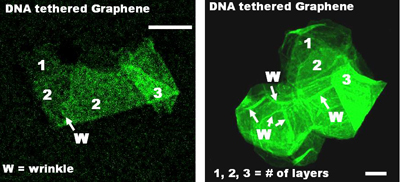Engineers from Kansas State University in the USA believe that the capabilities of an extremely thin material are many

Researcher Vikas Berry, a professor of chemical engineering at the University of Kansas, is leading research that merges biological materials with graphene - a recently developed carbon material that is only one atom thick. "The combination of biological materials and graphene advances the use of this material a step forward," explains the researcher. "This material, which was discovered only four years ago, is already demonstrating a large number of capabilities."
To examine the graphene, the researchers rely on an atomic force microscope (AFM) to help them observe and manipulate these thin sheets of carbon. "Working with this material is simply fascinating," says the researcher. "The most significant characteristic of graphene lies in the fact that the electrons in it are able to move without interference, at a speed close to the speed of light and at room temperature. Normally you have to reach absolute zero - that is, about two hundred and seventy-three degrees Celsius below zero to make the electrons move at such a speed."
One of the developments of this scientist is a DNA sensor. Graphene-based. During the movement of the electrons in the graphene, they change their speed when they come into contact with the isolated DNA. The researchers noticed this change by measuring the electrical conductivity. The research was published in the scientific journal Nano-Letters.
"Most DNA sensors are optical, but ours is electric," explains the researcher. "We are currently collaborating with researchers from the Harvard Medical School to develop a device capable of "sensing" cancer cells in the blood." Another area of his research is attaching antibodies to graphene and examining this array against the presence of bacteria. "Most researchers focus on pure graphene, but we prepare it impurely," the researcher points out.
Two chemical engineers from his research group used a type of bacteria common in rice and mixed it with the substance. They discovered that graphene to which antibodies were attached wraps the entire volume of the bacteria that remains active for about twelve hours.
The lead researcher points out that possible applications of these findings include an efficient battery powered by bacteria, when a geobater type bacteria, known as an electron producer, can be used to cover it with graphene to generate electricity.
"Materials science is an impressive field where it is possible to utilize a number of quantum principles operating at the molecular level, and biology is another impressive field that includes a variety of unique biochemical mechanisms," adds the researcher. "However, for the most part, these two areas are completely separate. If you are able to connect these two areas, the possibilities are unlimited. For example, it is possible to treat a bacterium as a machine with components of molecular size and use the activity of these components in various devices." In his doctoral thesis, the researcher himself used a bacterium to develop a humidity sensor. "This was only possible thanks to the combination of materials science with biological science," he explains.
Another area of his research is the contraction and stretching of molecular junctions between nanoparticles. The researcher explains that his group has developed a molecular spring device that is capable of contracting and stretching coils, which behave similarly to springs, thus allowing the researchers to examine how they return to their original state. He explains that this technology could be used to create molecular stopwatches in which the spring activity of disintegrating particles located on a chip could close an electrical circuit. The idea behind this approach was to place the device inside a centrifuge and stretch the particles using the centrifugal force.
